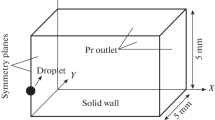Abstract
In this work, we studied numerically the dynamic behaviour of droplet impact over two different wettability surfaces having equilibrium contact angles of 91° and 147° in hydrophilic and hydrophobic range, respectively. Numerical simulations are performed using an in-house code based on Dual Grid Level Set Method (DGLSM) (Gada and Sharma in Numerical Heat Transfer, Part B: Fundamentals 59:26–57, 2011) as an interface tracking method. We implemented Yokoi’s dynamic contact angle model in solver, in which the dynamic contact angle varies as the function of contact line velocity. We considered the computational domain as 2D cylindrical axisymmetric. An in-house code developed by (Gada, V. H. (2012). A novel level-set based CMFD methodology in 2D/3D Cartesian and cylindrical coordinates and its application for analysis of stratified flow and film boiling. IIT Bombay.) with modifications on contact line velocity is implemented, considering the dynamic contact angle as a boundary condition in the DGLSM (Yokoi et al. in Phys Fluids 21, 2009). Sudden jumps in thermo-physical properties across interface are smoothened by considering the interface to be diffused. It has been found that implementation of Second-Order Upwind (SOU) and First-Order Upwind (FOU) schemes to approximate contact line velocity show a good match of numerically obtained temporal variation of droplet diameter and droplet height, with published results for both the bouncing and non-bouncing droplets. But the Quadratic Upstream Interpolation for Convective Kinematics (QUICK) scheme gives a comparatively better result specifically for bouncing and errors for non-bouncing cases.
Access this chapter
Tax calculation will be finalised at checkout
Purchases are for personal use only
Similar content being viewed by others
References
Gada VH, Sharma A (2011) On a novel dual-grid level-set method for two-phase flow simulation. Numer Heat Transf Part B: Fundament 59(1):26–57
Gada VH (2012) A novel level-set based CMFD methodology in 2D/3D Cartesian and cylindrical coordinates and its application for analysis of stratified flow and film boiling. IIT Bombay
Yokoi K, Vadillo D, Hinch J, Hutchings I (2009) Numerical studies of the influence of the dynamic contact angle on a droplet impacting on a dry surface. Phys Fluids 21(7):072102
Galliker P, Schneider J, Eghlidi H, Kress S, Sandoghdar V, Poulikakos D (2012) Direct printing of nanostructures by electrostatic autofocussing of ink nanodroplets. Nat Commun 3(1):1–9
Lu Y, Sathasivam S, Song J, Crick CR, Carmalt CJ, Parkin IP (2015) Robust self-cleaning surfaces that function when exposed to either air or oil. Science 347(6226):1132–1135
Jia W, Qiu HH (2003) Experimental investigation of droplet dynamics and heat transfer in spray cooling. Exp Therm Fluid Sci 27(7):829–838
Patil ND, Shaikh J, Sharma A, Bhardwaj R (2022) Droplet impact dynamics over a range of capillary numbers and surface wettability: assessment of moving contact line models and energy budget analysis. Phys Fluids 34(5):052119
Hoffman H, Sijs R, de Goede T, Bonn D (2021) Controlling droplet deposition with surfactants. Phys Rev Fluids 6(3):033601
Lin Y, Chen H, Wang G, Liu A (2018) Recent progress in preparation and anti-icing applications of superhydrophobic coatings. Coatings 8(6):208
Li H, Zhang K (2019) Dynamic behavior of water droplets impacting on the superhydrophobic surface: both experimental study and molecular dynamics simulation study. Appl Surf Sci 498:143793
Zhang X, Zhu Z, Zhang C, Yang C (2020) Reduced contact time of a droplet impacting on a moving superhydrophobic surface. Appl Phys Lett 117(15):151602
Wang Z, Lopez C, Hirsa A, Koratkar N (2007) Impact dynamics and rebound of water droplets on superhydrophobic carbon nanotube arrays. Appl Phys Lett 91(2):023105
Jung YC, Bhushan B (2009) Dynamic effects induced transition of droplets on biomimetic superhydrophobic surfaces. Langmuir 25(16):9208–9218
Patil ND, Gada VH, Sharma A, Bhardwaj R (2016) On dual-grid level-set method for contact line modeling during impact of a droplet on hydrophobic and superhydrophobic surfaces. Int J Multiph Flow 81:54–66
Šikalo Š, Wilhelm HD, Roisman IV, Jakirlić S, Tropea C (2005) Dynamic contact angle of spreading droplets: experiments and simulations. Phys Fluids 17(6):062103
Griebel M, Klitz M (2014) Simulation of droplet impact with dynamic contact angle boundary conditions. In: singular phenomena and scaling in mathematical models, Springer, Cham, pp 297–325
Acknowledgements
N.D.P. gratefully acknowledges the financial support under start-up-research-grant (SRG) scheme from SERB-DST, Govt. of India, New Delhi, by grant number SRG/2020/001947, for the computational workstation used in the present work’s simulation.
Author information
Authors and Affiliations
Corresponding author
Editor information
Editors and Affiliations
Rights and permissions
Copyright information
© 2024 The Author(s), under exclusive license to Springer Nature Singapore Pte Ltd.
About this paper
Cite this paper
Sahoo, P., Shaikh, J., Patil, N.D., Das, P. (2024). Influence of Contact Line Velocity Implementation in Dynamic Contact Angle Models for Droplet Bouncing and Non-bouncing Dynamics on a Solid Substrate. In: Singh, K.M., Dutta, S., Subudhi, S., Singh, N.K. (eds) Fluid Mechanics and Fluid Power, Volume 5. FMFP 2022. Lecture Notes in Mechanical Engineering. Springer, Singapore. https://doi.org/10.1007/978-981-99-6074-3_11
Download citation
DOI: https://doi.org/10.1007/978-981-99-6074-3_11
Published:
Publisher Name: Springer, Singapore
Print ISBN: 978-981-99-6073-6
Online ISBN: 978-981-99-6074-3
eBook Packages: EngineeringEngineering (R0)




